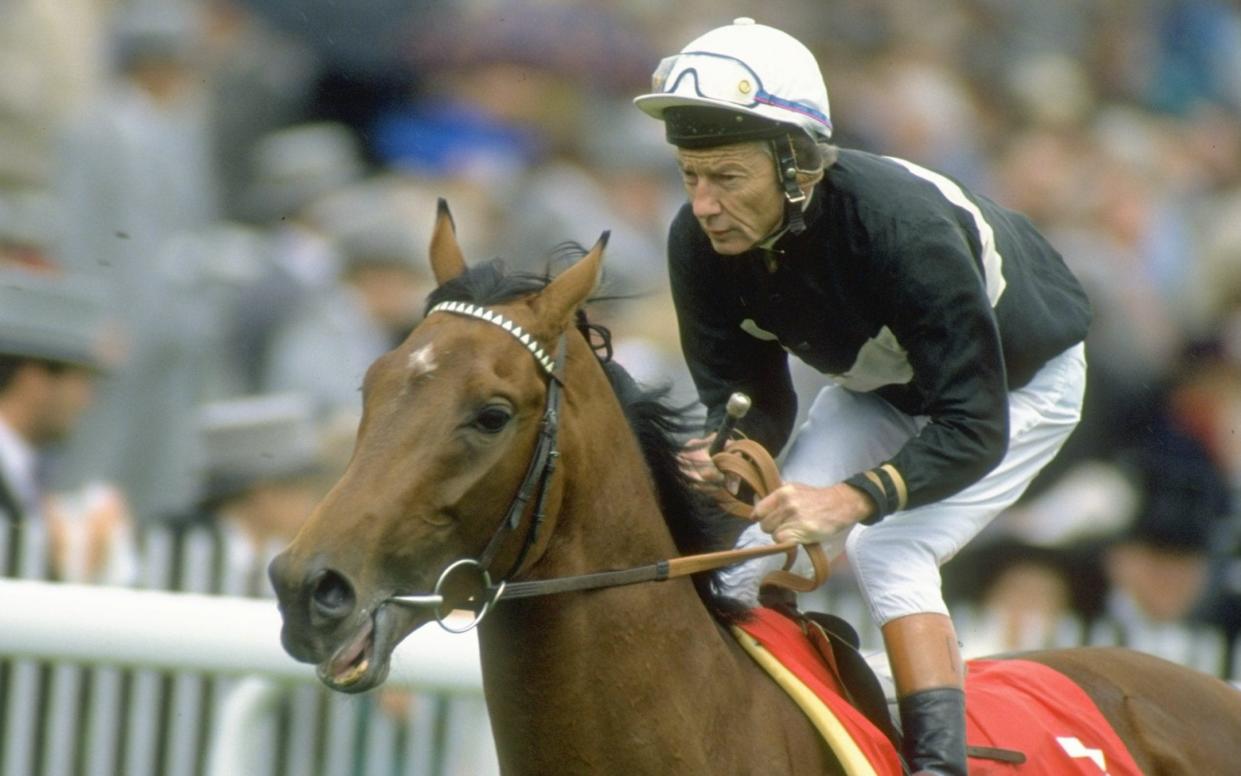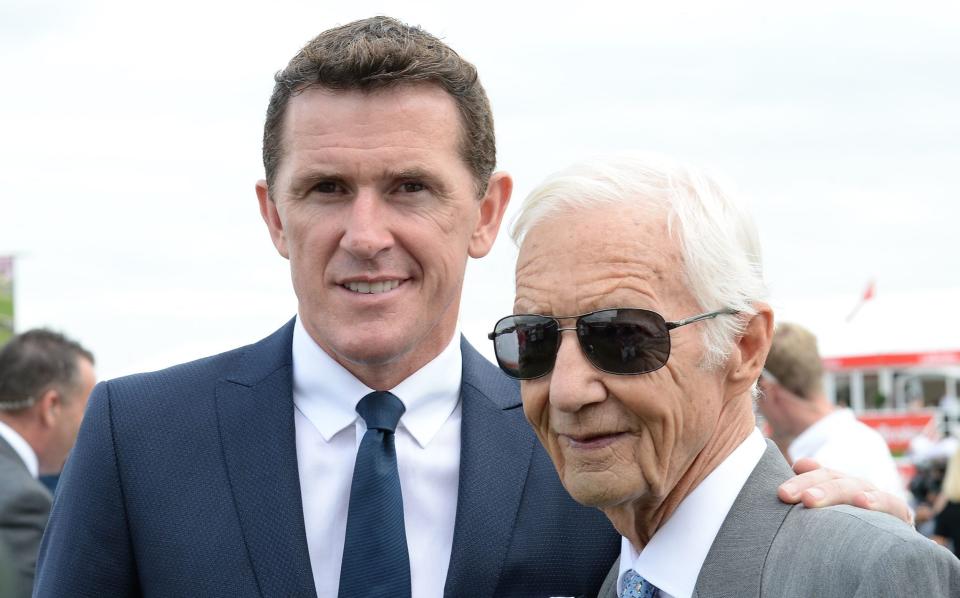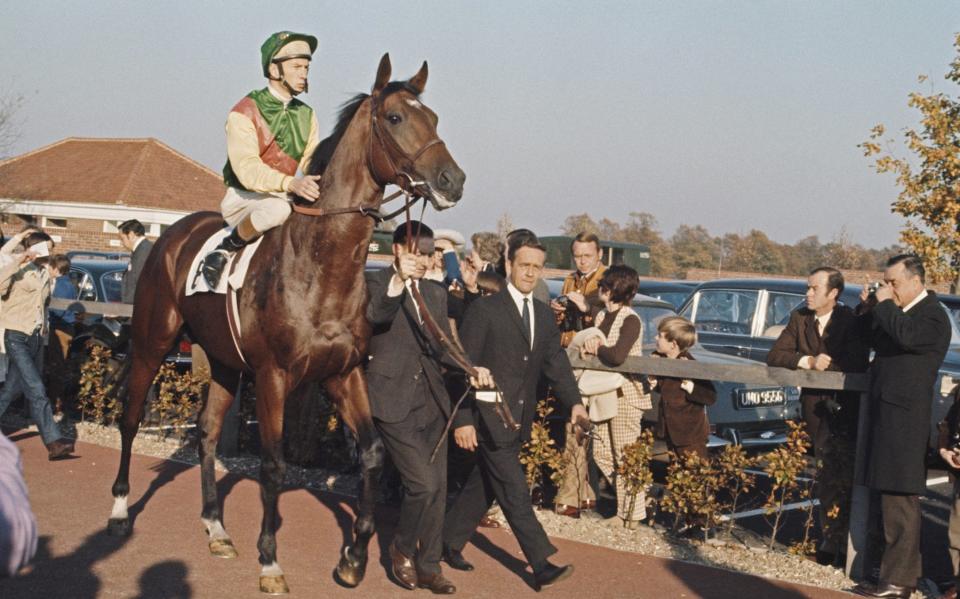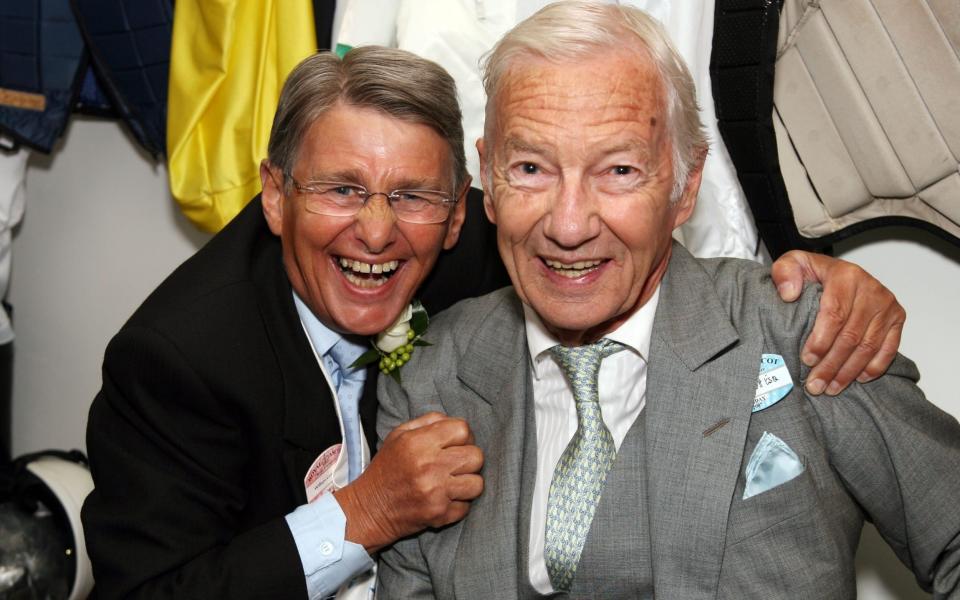Lester Piggott, legendary jockey and nine-time Derby winner, dies aged 86

Lester Piggott, the greatest jockey of the 20th century with a record nine Derby winners to his name and one of the most enduring sportsmen of all time with a career spanning 46 years, has died aged 86.
Nicknamed “The Long Fellow” and once likened to having a face like a “well-kept grave”, few professional sportsmen will ever match Piggott for either his success, longevity or the narrative of his time in the saddle which incorporated everything from being a teenage riding sensation, decades at the top, a spell in jail for tax evasion and then one of sport’s greatest comebacks.
On top of it all, he had to overcome being partially deaf. But he was born into a racing dynasty – his grandfather Ernie rode two Grand National winners, his father Kieth trained one.
At 5ft 8in he was tall for a jockey in those days and maintained a weight of 8st 6lbs, a weight no self-respecting top jockey would consider acceptable these days, on a diet of cigars and champagne.
He was also born with a healthy disregard for authority and convention, plus quite a few trainers and journalists. He was a remarkable jockey with a singular personality and while his record of 4,493 winners including 30 domestic Classics speaks for itself, if the mark of a great sportsman is to change the way a sport is practised then, in that respect alone, he achieved greatness by changing the way jockeys rode.
When Piggott rode his first winner, The Chase at Haydock, in 1948 aged 12, most jockeys still rode hunting length. But gradually Piggott shortened his stirrup leathers until, with incredible balance, he was perched on the horse’s withers with his famous “derriere” in the air. On his radio show, Noel Edmonds even had an imaginary place called Piggott’s Bottom. His style was often described as inimitable but every jockey since has tried to copy it.

It is his association with the Derby for which he will be best remembered. For most of his career “international” racing meant France and Ireland, although European runners were starting to explore valuable opportunities in America towards the end of his career and Hong Kong was coming on stream.
You could argue all day and night now about which the greatest or most important race is but, in Piggott’s time, there was no argument about it – the Derby was the world’s most important race. London emptied to Epsom for the day and at the start of each June there was just one question: what would Lester ride?
His first ride in it was as a 15-year-old, a year before any modern jockey could get a licence, on Zucchero for Ken Cundall who had spotted his prodigious and precocious talent.
It was before starting stalls, there were 33 runners and Zucchero, a tempremental starter, had to be led in by his trainer but got left at the start and finished down the field behind Arctic Prince. In the King George at Ascot Zucchero finished six lengths in front of Arctic Prince. Piggott always considered it to be “the one that got away”.
He did not have to wait long before triumphing on Never Say Die aged 18 in 1954 and, for the next three decades, no-one mastered the contours of Tattenham Hill like Piggott, who had an uncanny knack of imposing his will on horses.
His next two were for Noel Murless on Crepello (1957) and St Paddy (1960) but his link with Vincent O’Brien led to his most productive spell in the race when he won it five times in 10 years. O’Brien trained four of those horses, Sir Ivor (1968), Nijinsky (the Triple Crown winner in 1970), Roberto (1972) and The Minstrel (1977).

In between he rode Empery (1976) for Maurice Zilber and his last winner was Teeneso for Geoff Wragg. In all he rode in it 36 times at a strike rate of one in four. Twice in narrow wins you could argue that had you swapped the jockeys there would have been a different result.
“I could have ridden two or three more Derby winners if things had panned out differently” Piggott told Telegraph Sport in 2015. “If I’d stayed with Vincent O’Brien a bit longer or stayed with Noel Murless a bit longer it could easily have happened.”
Having been replaced at Ballydoyle by Pat Eddery, after El Gran Senor’s narrow defeat by Secreto, Piggott was supposed to have walked back to weigh in past O’Brien and Robert Sangster, who were licking their wounds in the second spot, and muttered: “Do you miss me?”
His run-ins with authority were legion. He was cautioned or suspended for bumping four times as a 14-year-old although there may have been a bit of the Jockey Club’s “old farts” putting the upstart jockey back in his box.
In 1950 he was suspended for three weeks by the Jockey Club for riding “with disregard for other jockeys”. In no Piggott incident, however, was anyone ever hurt.
But whether it was stealing another jockey’s whip after dropping his own mid-race or pinching another jockey’s mount a few days before a big race, often bypassing the trainer by going straight to the owner, Piggott was never far from the headlines.

He was a man of few words and long silences but what he did say was often very astute or highly amusing. When Ben Leigh, a small operator, told Piggott after a race that he would never ride for him again Piggott mumbled his reply: “Well, that’s me finished then.”
Piggott often said that a good jockey did not need instructions and that a bad one couldn’t carry them out anyway.
On another occasion, riding for Johnnie Haine, he was told to put the horse’s head in front on the line. With total disregard for the instruction Piggott set off in front, made all the running but was caught in the shadow of the post. Haine was furious. “You were quite right, y’know” said Piggott as he dismounted and walked away.
In 1985 he retired to start training in Newmarket but he was convicted of tax evasion – mainly because the cheque he paid the revenue with was from an account he had not declared – and served 366 days in prison while his wife, Susan, trained.
On his release after five years out of the saddle, encouraged by O’Brien whose stable jockey John Reid was injured, he started riding again. He had been back in the saddle for 10 days when he won the Breeders’ Cup Mile on Royal Academy, turning into the straight last and sweeping past the field to get up on the line.
He was not finished. He teamed up with Robert Sangster again to win the 1992 2,000 Guineas on Rodrigo de Triano and, after riding the horse in a pre-Derby gallop with his stable companion Dr Devious, he tried his old trick of swapping mounts for Epsom. Dr Devious won under Reid. His career finally fizzled out in 1995 when he retired for the second and last time. He spent much of his retirement in Switzerland.
'He was magical on a horse' - fellow jockeys pay tribute to prolific winner Piggott
By Marcus Armytage
Frankie Dettori and Willie Carson were among those leading the tributes to Piggott, who died peacefully in a Swiss Hospital during the early hours of Sunday morning aged 86.
“It’s very sad,” said Dettori who sent him a video wishing him well three days ago. “I rode for him and with him and for the last few years of his career we travelled the world together.
“I even rode in the Breeders’ Cup Mile in 1990 when he made his comeback on Royal Academy. To me that was his best ride, he was 56 coming back after five years off. He walked back into the weighing room after, as if it was completely normal. But there was nothing normal about it.
“Because I hadn’t been brought up here I had a different rapport with him to most people. I was never afraid of him while most people were petrified. He had a great sense of humour and was fun. I used to tell him he should be stuffed and put in a museum.”

Carson, who had numerous tussles on the racecourse with him, described him as ‘God.’ He said: “Lester was an iconic figure in the racing industry and changed the way things were done from his early days until he retired. We all had to up our game because of him.
“He was magical on top of a horse. He has this confidence about him and didn’t care what people were going to think about him - he just got on and did what he thought was the right thing on a horse and it normally was.
“He had an empathy for the animal and knew what a horse was thinking. He knew what a horse wanted, be it tough, soft, holding up or using his stride and he always seemed to get it right.”

The American jockey Steve Cauthen, whose own place in weighing room legend was gained by being the only person to ride the winners of the Epsom and Kentucky Derby, said: “When I came over (1979) what he was hoping to do was to send me packing pretty quick. But he realised I was going to stay. We were competitors and we had a few little tugs of war but eventually came to respect each other.
“I always admired his talent and unique ability which was impossible to copy though everyone tried. You hear all the stories about the penny-pinching but he did a lot of kind things behind the scenes which he didn’t want anyone to know about. He was a special, unique guy, a great judge who knew which the best horses were and was pretty good at getting on most of them. His Breeders Cup was the most amazing thing I ever saw in racing.”
Piggott rode a lot of winners for Luca Cumani including Commanche Run in the 1984 St Leger. “He was a great man and a fantastic jockey,” said Cumani. “The best there has ever been, a unique piece of racing history. He was a fantastic horseman and a law unto himself. Lester did what Lester wanted. There’ll never be another.”
Piggott’s last Classic winner was Rodrigo de Triano for Peter Chapple-Hyam in the 1992 2,000 Guineas. “I was in awe of him,” said the trainer who was just 29 at the time. “He was the greatest jockey there has ever been and he rode in a golden era for jockeys. He was top of the tree, ruthless, and if there was a good horse he got on it.”
Recalling Rodrigo de Triano’s Classic win, he added: “Willie (Carson) had ridden him but was claimed to ride for Sheikh Hamdan, I tried Walter (Swinburn), John Reid but they all had rides in it but Robert Sangster took a lot of persuading to put Lester up even though they were old pals.
“When I suggested it Robert said: ‘He’s older than me and he’s old enough to be your father. Would you put your father up?’ I said ‘no chance’ but eventually he came round and said ‘go on then, put the old man on board.’ It worked out perfectly.”

 Yahoo News
Yahoo News 
